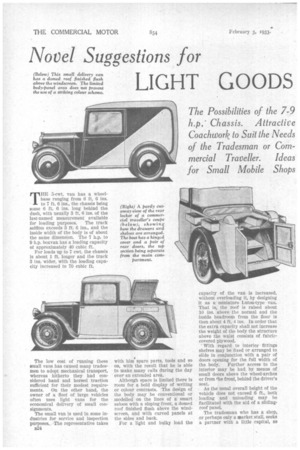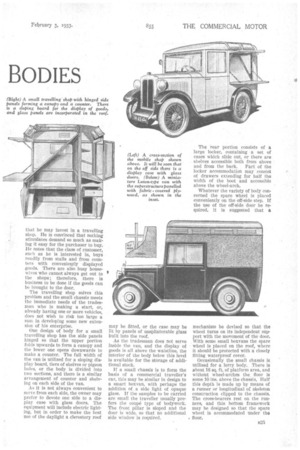Novel Suggestions for
Page 38

Page 39

If you've noticed an error in this article please click here to report it so we can fix it.
LIGHT GOODS BODIES
The Possibilities of the 7-9
h.p.Chassis. Attractive
Coachwork to Suit the Needs of the Tradesman or Com mercial Traveller. Ideas for Small Mobile Shops
TI1E 5-cwt. van has a wheelbase ranging from 6 ft. 6 ins.
• to 7 ft. 6 ins., the chassis being some 6 ft. 6 ins, long behind the dash, with usually 3 ft. 6 ins, of the last-named measurement available for loading purposes. The track seldmn exceeds 3 ft. 6 ins., and the inside width of the body is of about the same dimension. The 7 h.p. to 9 h.p. boxvan has a loading capacity of approximately 40 cubic ft..
For loads up to 7 cwt. the chassis is about 1 ft. longer and the track 3 ins, wider, with the loading capacity increased to 70 cubic ft.
The low cost of running these small vans has caused many tradesmen to adopt mechanical transport, whereas hitherto they had considered hand and horsed traction sufficient for their modest requirements. On the other hand, the owner of a fleet of large vehicles often uses light vans for the economical delivery of small consignments,
The small van is used in some industries for service and inspection purposes. The representative takes B24
with him. spare parts, tools and so on, with the result that he is able to make many calls during the day over an extended area.
Although space is limited there is room for a bold display of writing or colour contrasts. The design of the body may be conventional or modelled on the lines of a smart saloon with a sloping front, a domed roof finished flush above the windscreen, and with curved panels at the sides and back.
For a light and bulky load the capacity of the van is increased, without overloading it, by designing it as a miniature Luton-type van. That is, the roof is raised about 10 ins, above the normal and the inside headroom from the floor is then about 4 ft. 4 ins. In order that the extra capacity shall not increase the weight of the body the structure above the waist consists of fabriccovered plywood.
' With regard to interior fittings shelves may be fixed or arranged to slide in conjunction with a pair of doors opening for the full width of the body. Further access to the interior may be had by means of small doors above the wheel-arches or from the front, behind the driver's seat.
As the usual overall height of the vehicle does not exceed 8 ft., both loading and unloading may be facilitated with the aid of a slidingroof panel.
The tradesman who has a shop. or perhaps only a market stall, seeks a partner with a little capital, so that he may invest in a travelling shop. He is convinced that nothing stimulates demand so much as making it easy for the purchaser to buy. He notes that the class of customer, such as he is interested in, buys readily from stalls and from counters with conveniently displayed goods. There are also busy housewives who cannot always get out to the shops; therefore, there is business to be done if the goods can be brought to the door.
The travelling shop solves this problem and the small chassis meets the immediate needs of the tradesman who is making a start, or, already having one or more vehicles, does not wish to risk too large a sum in developing some new extension of his enterprise.
One design of body for a small travelling shop has the side panels hinged so that the upper portion folds upwards to form a canopy and the lower one opens downwards to make a counter. The full width of the van is utilized for a sloping display board, tiers of shelves or pigeon holes, or the body is divided into two sections, and there is a similar arrangement of counter and shelving on each side of the van.
As it is not always convenient to serve from each side, the owner may prefer to devote one side to a display case with glass doors. The equipment will include electric lighting, but in order to make the best use of the daylight a clerestory roof
may be fitted, or the case may be lit by panels of unsPlinterable glass built into the roof.
As the tradesman does not serve inside the van, and the display of goods is all above the waistline, the interior of the body below this level Is available for the storage of additional stock.
If a small chassis is to form the basis of a commercial traveller's ear, this may be similar in design to a smart boxvan, with perhaps the addition of . a side light of opaque glass. If the samples to be carried are small the traveller usually prefers the coupe type of bodywork. The front pillar is sloped and the door is wide, so that no additional side window is required.
The rear portion consists of a large locker, containing a set of cases which slide out, or there are shelves accessible both from above and from the back. Part of the locker accommodation may consist of drawers extending for half the width of the boot and accessible above the wheel-arch.
Whatever the variety of body concerned the spare wheel is placed conveniently on the off-side step. It the use of the off-side door be required, it is suggested that a mechanism be devised so that the wheel turns on its independent support with the movement of the door. With some small boxvans the spare wheel is placed on the roof, where it should be protected with a closely fitting waterproof cover.
Occasionally the small chassis is utilized for a lorry body. There is about 16 sq. ft. of platform area, and without wheel-arches the floor is some 10 ins, above the chassis. Half this depth is made up by means of a runner or longitudinal of skeleton construction clipped to the chassis. The cross-bearers rest on the runners, and this bottom framework may be designed so that the spare wheel is accommodated under the
• floor.




























































































